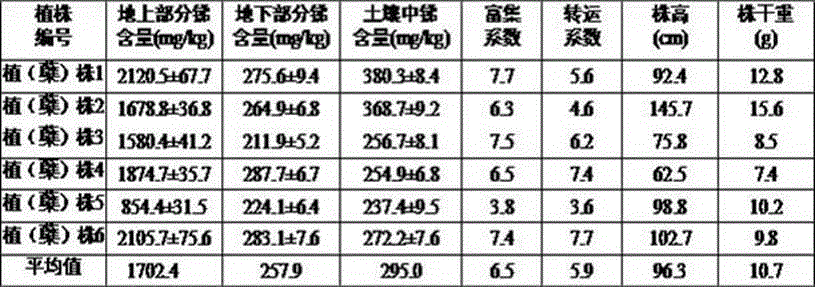Method for removing antimony pollution by using plant miscanthus sinensis anderss
A technology for plants and contaminated areas, applied in the field of phytoremediation, can solve the problems of difficult to find and remediate plants, animals and microorganisms, difficult soil storage and treatment, large engineering workload, etc., and achieves strong operability and does not cause secondary pollution , the effect of strong adaptability
- Summary
- Abstract
- Description
- Claims
- Application Information
AI Technical Summary
Problems solved by technology
Method used
Image
Examples
Embodiment Construction
[0015] The awns grown naturally in antimony-contaminated soil in an antimony-polluted area in Hunan were used for experimental research. Under the antimony-polluted environment, when the awn plants grow to maturity, the whole plant, including its above-ground and underground parts, was harvested and removed. Randomly collect 6 awns and the soil corresponding to their growth, and use the following method to process and measure the antimony content in them. This method can be briefly described as natural air drying of samples - nitric acid + perchloric acid digestion and constant volume - ICP determination. The specific operation process is as follows : Process and store the collected awns according to the plants, first clean them with tap water, rinse them with distilled water, and air-dry them, divide them into aerial parts and underground parts according to the plants, and cut the aboveground parts and underground parts into small pieces with scissors according to the plants (a...
PUM
 Login to View More
Login to View More Abstract
Description
Claims
Application Information
 Login to View More
Login to View More - R&D
- Intellectual Property
- Life Sciences
- Materials
- Tech Scout
- Unparalleled Data Quality
- Higher Quality Content
- 60% Fewer Hallucinations
Browse by: Latest US Patents, China's latest patents, Technical Efficacy Thesaurus, Application Domain, Technology Topic, Popular Technical Reports.
© 2025 PatSnap. All rights reserved.Legal|Privacy policy|Modern Slavery Act Transparency Statement|Sitemap|About US| Contact US: help@patsnap.com

